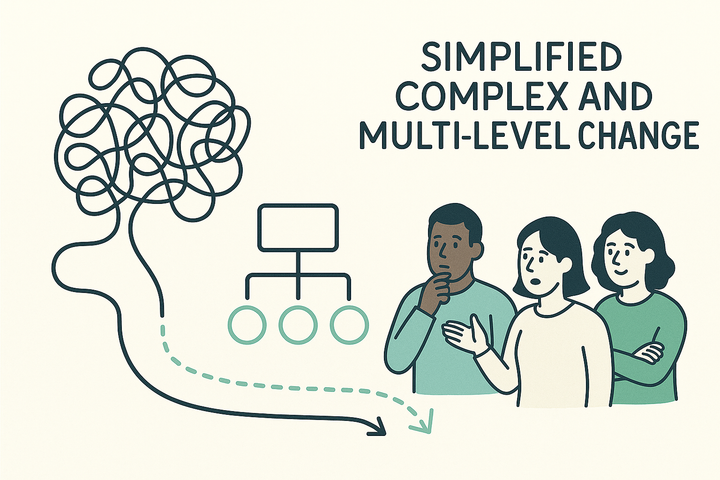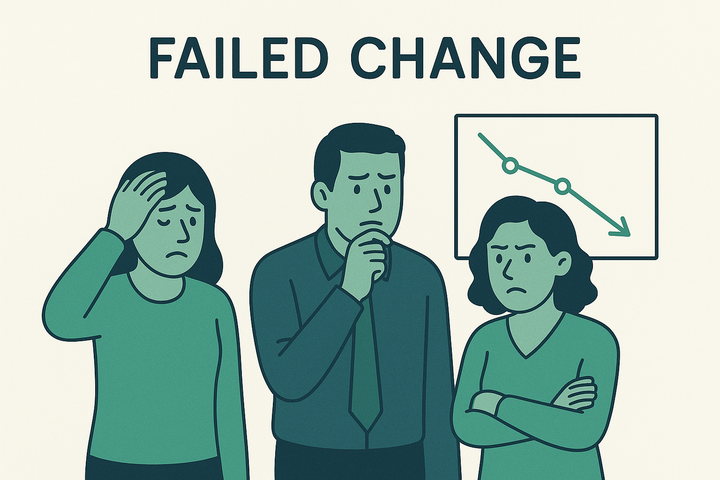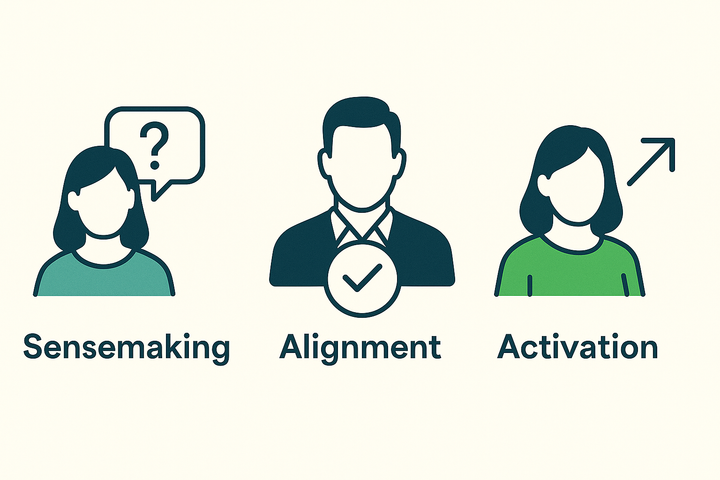With Not To – Why Employee Engagement Has to Be Real, Not Faked
You can’t fake engagement. Employees know when they’re being ‘done to.’ This article explores how to involve people meaningfully in change — and why it matters more than ever.

The Engagement Illusion
You’ve seen it happen.
A town hall with a Q&A box.
An engagement survey with a 5-day window.
A “working group” that gets thanked in the end slide, but didn’t shape the decision.
It all looks like engagement. But it isn’t.
Because the decision was already made. The shape of the change already locked in. The “engagement” was just theatre.
And here’s the thing: your people can tell.
They know when they’re being invited to react rather than contribute. When they’re being consulted for show, not for substance. And once they clock that, they disengage.
The engagement gap
Most organisations know they need to involve people in change. But few stop to ask: what kind of involvement are we offering?
There’s a big difference between:
- Engagement as endorsement — “We’ve made the call. Let’s get them on board.”
- Engagement as shaping — “We’re working it through. Let’s bring them in early.”
When you engage with people, you build belief. When you do change to them, you build resistance.
The result of fake engagement?
- Frustration
- Cynicism
- Low trust
- Message fatigue
- Delays and workaround behaviours
And the worst part? You burn through the credibility you’ll need later, when real things start to shift.
Why it happens
Let’s be honest. Real engagement is harder. It takes time. It invites challenge. It adds complexity.
So, many organisations default to the performance version:
- Ask a few questions
- Run a survey
- Hold a session
- Publish a “you said, we did” post
Box ticked. Comms done.
But if the outcome was never going to change — if the route was already chosen — then people weren’t engaged. They were informed. At best.
Other reasons it happens:
- Timelines are too tight to build feedback loops
- Leaders fear losing control of the narrative
- Engagement is seen as HR’s job, not a strategic lever
- The engagement plan is built after the strategy, not before
What real engagement looks like
This doesn’t mean handing over every decision. It means designing the process with participation in mind.
Examples of real engagement:
- Involving staff in shaping the change narrative, not just reviewing the messaging
- Co-designing elements of the transformation — like pilots, workflows or principles
- Running structured listening that informs the actual design of the change
- Letting teams identify pain points before offering fixes
- Creating two-way forums where leaders engage with challenges, not just deliver answers
The golden rule? People don’t need total control. But they do need to see where their input made a difference.
The ROI of real engagement
When it’s done well, real engagement creates momentum you can feel. It builds psychological safety and trust, especially during times of uncertainty, giving people the confidence that they’re being heard, not just managed. It surfaces risks and blind spots early, before they become costly issues downstream. And it creates natural advocates: the people inside the organisation who amplify the message because they helped shape it.
Engagement also makes implementation smoother. When people have been part of the thinking, they’re more likely to support the doing. That shared ownership translates into better adoption, fewer misunderstandings, and stronger team pride in the outcomes.
And here’s the truth, most organisations learn the hard way: fake engagement is worse than no engagement at all. If you ask people for their views and then ignore them, you don’t just waste time — you erode trust. And once that’s broken, it’s hard to get back.
How to spot performative engagement (and fix it)
You’re in danger of faking it if:
- You’re “engaging” after the decisions have already been made
- Your sessions involve a lot of talking at and very little listening
- You run a survey but have no plan to feed back or act
- Your feedback loops are so long they become irrelevant
- You ask for ideas but never show what happened to them
You can fix this by:
- Designing engagement before you finalise the change approach
- Building feedback into your governance — not as a gesture, but as a checkpoint
- Sharing clear updates on how input was used — and being honest where it wasn’t
- Training leaders to engage with the challenge, not avoid it
- Using engagement to shape communication, not just validate it
Final thought
The difference between “with” and “to” is everything.
“With” creates commitment.
“To” creates resistance.
If you want your people to believe in the change, you can’t just ask them to nod along. You have to bring them in. Early. Properly. Honestly.
Real engagement is not a campaign. It’s a commitment.
And it’s the difference between change that sticks — and change that fails quietly.
Need help making your engagement real?
Start with the Sound & Signal Review — our diagnostic that shows whether your comms and engagement are actually landing, or just going out.
Or, if the programme is underway and people are pulling back, the Rapid Action Accelerator can help you reset, re-engage and get moving again — with your people, not without them.



